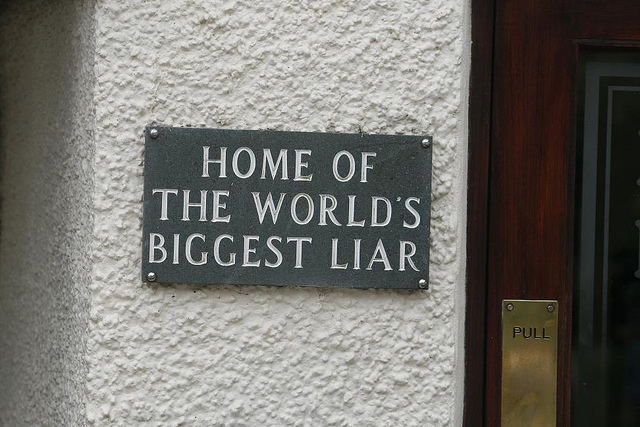“Fake news” is ubiquitous—in this article, I’m talking about the phrase, not the news itself.
It was everywhere during the election, and surely it’s still out there, but more than anything, the phrase “fake news” has become a rallying cry.
For the left, it is part of a reason why the election was lost and why Trump cannot be trusted, and illustrates that the current administration is clearly pushing propaganda as opposed to facts. (Though recently, “fake news” has been replaced with “alternative facts,” which Kellyanne Conway herself admitted to doing, making it feel more justified.)
For the right, it shows that the media as a whole cannot be trusted—because if one reporter at CNN is reporting fake news, then how can we trust anyone at CNN? Because if the media is not covering terrorist attacks, how can we trust them to report all of the other things we deserve to know about?
And Trump is making no bones about throwing the phrase around on Twitter and in press conferences, as evidenced by the February 16 presser, where he called out CNN and BBC by name as well as referring to the “failing New York Times” and stating that the leaks were real but the news about them was fake.
Chris Cuomo, in his interview with Sen. Blumenthal, never asked him about his long-term lie about his brave “service” in Vietnam. FAKE NEWS!
— Donald J. Trump (@realDonaldTrump) February 9, 2017
Nothing was ever specified in regards to what was “fake” and simply not what they wanted out in the world. But this type of rhetoric is dangerous and has proven to have an effect on the American public’s relationship with the media.
A recent poll—granted a quite small one, with a sampling of only 617, though it “echoes” Gallup’s annual poll—found that 53 percent of people polled do not find the media trustworthy.
This is a frightening idea for a number of reasons, not the least of which is that we, as the public, have to be able to trust the press to a certain extent. We cannot be everywhere in the world at once, so we have to be able to rely on reporting that informs us what is going on.
If you’re having trouble trusting the press, or you are feeling like anywhere you look is biased, or even fake, news, or you just want to be sure you are as well informed as possible and not contributing to the issue, here are some tips:
Know Your Sources
There are a number of ways to figure out what sources you are reading and who they are owned by. There is, in fact, a helpful graph being passed around on social media that shows the political leanings of the most popular media and the quality of the writing.
If you are reading a particular news site on a regular basis, go to their About page (normally just labeled “About” at the very bottom of the homepage) or simply Google “Is [name of site] biased?” or “Is [name of site] liberal or conservative?”
You will find a clear answer pretty easily. You can also visit AllSides.com and click on “Bias” in the top menu. They have a list of online news outlets and explanations of why they have a particular rating. Keep in mind that their bias ratings do not include opinion pieces. If you’re reading news online, you always want to check and see if you are reading an opinion piece or not. Everyone has an opinion, but any pieces with that label will not be factual alone; hopefully they will be based on facts, but they will definitely exhibit the writer’s bias, so take them with the proverbial grain of salt.
Expand Your Reading
When you’re reading something that completely supports your already preconceived notions of an issue, search for the topic on other sites. For instance, if you see that there’s been a tweet about a federal department or agency suddenly changing its policies or deleting some kind of regulations from its website, look it up. Sure, you can click on the tweet and see what people are saying, but do your best to not get riled until you read a few different news reports on it.
For instance, the USDA recently deleted animal abuse records online. It’s easy to get upset about this because it has far-reaching implications. But that’s all it began as: implications. Before we state the sky is falling, we should know what’s really already happened and what hasn’t. So when it first happened, I read a CNN story, a Christian Science Monitor story, and watched Tucker Carlson cover it on Fox. It provided a much more well-rounded idea of what was going on. Because, let’s face it: no one source is going to provide all the information that we may want and need to make a decision for ourselves. And honestly, a single source shouldn’t be that for us.
Any news story we read should entice us to read more on an issue, not start to protest and decry something without further knowledge.
Know What the Phrase “Fake News” Actually Means
When “fake news” first started to get tossed around, it was due to the idea that what was being spread was literally made up by a person. There have been a few exposés done on fake news stories’ origins recently. One interviewed the man who admits to originating “FBI Agent Suspected In Hillary Email Leaks Found Dead In Apparent Murder-Suicide” and another who crafted the story with the headline “BREAKING: ‘Tens of thousands’ of fraudulent Clinton votes found in Ohio warehouse.”
These are fake news in the sense that they are completely made up.
When the TIME magazine reporter tweeted that the bust of Martin Luther King, Jr., had been removed from the Oval Office, it was, strictly speaking, not “fake news.” It was inaccurate, and the reporter corrected the error. Reporters are not fiction writers. If they were, well, they would have studied fiction instead of journalism. They would be writing short stories instead of news articles. However, they are human, which means they will make mistakes from time to time. Just as we, as citizens, are innocent until proven guilty, we should do our best to avoid labeling a reporter as guilty of “fake news” because the site or publication they work for has previously posted an error.
It is also dangerous to label it fake if we don’t like what it says. A doctor giving you bad results isn’t giving you fake information; it is just upsetting information because it is not what we want to hear. Taking that into account, we should always take a moment to let information sink in and then research the issue. Just as bad health news would make us—once we accepted it—begin to research what doctors we should go to and what treatments we should seek out, anything upsetting should be looked into further.
Don’t Put Too Much Stock in Headlines
Even the best news sites have fallen prey to the siren song of click-bait headlines. There are a lot of “smacks down” and “shuts down” and “lays into” used when that’s not really what happens in the videos and/or interviews after the link. One good tip is to watch out for anything that outright states “You Will Not Believe” or similar, especially in all caps.
If you get really curious about the headlines out there and what different sites are using, find some sites you wouldn’t normally go to and click on their headlines, paying attention to what the headline says and then what the article itself says. In my research, I found there were some sites that stated one thing in the headline but then did not actually contain that information in the article. Some didn’t even have an article and were paid sites that just tried to get me to sign up for online gambling.
If the headline seems inflammatory, it’s probably just click-bait, so read the article especially if you’re going to repost it or repeat the information. If you see a friend posting from ad sites where the article has nothing to do with the headline, maybe suggest they research their news a bit more rigorously—though unless you are incredibly tactful and very good friends, maybe direct message them that to not embarrass them. It’s not up to you to police their feed, but that doesn’t mean you can’t make a polite suggestion in privacy.
Share with Others…But Only if You’ve Read It in Full
Sometimes, it feels like we all get a little overexcited these days to share things that support our opinions—or, more than that, that support our emotions. If we’re outraged, it is satisfying to show our Facebook friends and Twitter followers that We. Were. Right.
The problem with this is that, in our zeal to do so, perhaps we only read the headline and then the first few paragraphs, not realizing that the rest of the article adds more balance to the allegations up front. Or we post from a site that has no credibility simply because the inflammatory headline reflects how we feel, but what we think we cannot say on our own.
I’ve read articles reposted by friends that don’t say what the friend’s post states it said.
This is important, not just because we should know if what we share is actually supporting what we think, but also so we do not distribute inaccurate information ourselves.
Beyond that, consider sharing and reposting only from sites that are in the neutral zone on bias and are considered good writing. If the idea of disseminating the information is to inform others and maybe, possibly, with the help of the heavens above to change someone’s mind, posting from sites that are considered biased or, worse, biased and poorly written, is not going to lend support to your argument.
And if you do repost, let me reiterate the second point above again: expand your reading. Before you share, know if other credible sources are reporting the same, so you can have confidence in your knowledge and what you are encouraging others to believe.
~
Author: Gretchen Stelter
Image: Alan Cleaver/Flickr
Editor: Catherine Monkman







Read 0 comments and reply